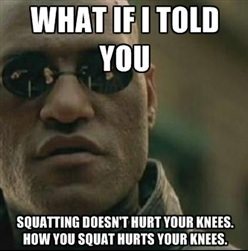
12 Feb Squat Deep
“My knees hurt so I can’t do it.”
“If I go that low, I’ll never be able to get back up.”
“At no point in my life could I go that low.”
And my favorite
“I heard in high school that you should never go past parallel.”
I have heard it all. And it all sucks.
So why do I keep bringing out a chair or tire for people and making them get their asses down low? Let’s break it down.
Anatomy:
Squatting makes its case for the best “Bang for your buck” exercises for good reason.
If you do it right, you upper back, core musculature (more than just abs), and everything in your legs gets used.
Let’s go a bit further and break the movement into two parts: eccentric (way down) and concentric (standing up).
Eccentric:
The movement starts by unracking the bar. Just to stand up with the weight, you must brace yourself to avoid being crushed underneath the heavy load. (heavy is relative FYI; heavy to me, to a world record holder, and to you are all different weights.)
When I say core musculature, most people instantly go to Abs; this is not incorrect, it is however, incomplete.
If you look closely at the Latissimus Dorsi, you will see the hip bones. The Lats (as they will be referred to here on out) are big and strong and when engaged, help keep your spine in line. Basically, they help make sure you don’t bend like a wet noodle.
Another powerful muscle group doing this job are the Erector Spinae, aka, the Spinal erectors. They run from your hips up the length of your spine. Their job is keeping your spine in line.
Back to everyone’s favorite: the Abs. Working in conjunction with the musculature of the back, the front helps balance us out. Bracing the core, rather than just arching our back keeps us from creating a whole host of other problems (and possibly another post….)
So now we have the bar unracked and we have talked about the core, and much like building a house, this is our foundation upon which build the movement.
We are in position and ready to begin. The simplest cues I give are: “Unlock your knees, and drop your hips.” Sounds easy right. Well there is a lot going on there.
Unlocking our knees takes the joint from what we call the close packed position, where the bones have the most contact with each other and is considered at its most stable, and into a loose packed position. Now, the muscles have to take over.
As we begin to lower down, the glutes and hamstrings, our primary hip external rotators and extensors, are being loaded up and stretched to prep for explosive extension. Because the hamstrings cross the knees, they don’t really shorten like the bicep does when you flex it, but they maintain an isometric contraction controlling the hip angle.
The knees must stay in line with the toes, in order to do so, we must externally rotate the femur (long bone of upper leg). This motion not only engages the external rotators of the hip, but also stretches the muscles of the inner thigh, our friends (or nemesis) the Adductors.
Anytime you flex your knees under a load, the Quadriceps are loaded. That’s the front of your leg. Lots of big and strong muscles, in particular the Rectus femoris.
This stretch phenomena we experience on the eccentric portion of the lift has a scientific name. The stretch-shortening cycle. To explain it simply, think about a rubber band. If I want to shoot a rubber band far, I pull it back creating tension so it can snap back and fly farther. The more I stretch it, the farther it will shoot. What we have done here is load up our muscles like a taut rubber band ready to be fired.
Enter the concentric phase.
Concentric:
Standing up we are using the same muscles we just talked about, but rather than loading them up, we are freeing them from the bondage of gravity and smashing headlong against it.
Our core must stay braced and rigid to work as an efficient energy transmitter. Abs tight, lats flexed, spinal erectors firing hard to keep the spine in line.
The Quads and posterior chain (glutes and hamstrings to you) must extend both the hips and the knees to get us back to standing up.
As we come up, we must keep the knees in line with the toes as that helps us prevent possible agitation and injury to its critical ligaments and tendons. It also gets our glutes going something fierce. (you’ve all seen the “She Squats” butt pictures on FB and Instagram…)
Am I painting the picture for you?
How Deep?
Now comes the interesting part. The bottom of the squat is an often debated point.
How deep should we go?
Isn’t too deep bad for the knees?
Remember, there are no stupid questions, only stupid people.
The best answer is as deep as you can.
Deep squats engage more muscles through a further range of motion. More muscle, higher metabolism, better fat loss, better athletic performance. Athletic performance doesn’t mean you’re going to be in the NFL combine, but any movement requiring coordination and strength is athletic; not falling on ice, picking up heavy things (groceries, suitcases, kids, etc.), playing with your kids, nieces and nephews, grandkids. All these things fall into the athletic movement category.
But my knees though…
We were born to do this.
In our ancient history this is how we sat when we didn’t have chairs, still how some people relieve themselves where there are no toilets, and how babies pick stuff up all the time.
We were born able to do this, but years of improper use or sedentary lifestyle have left us deficient in range of motion.
Now to give you some knee science.








